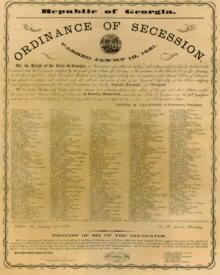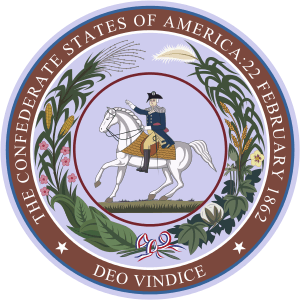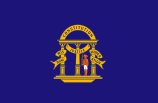Georgia in the American Civil War
| State of Georgia | |||||||||
| |||||||||
| Capital | Milledgeville | ||||||||
| Largest city | Savannah | ||||||||
| Admission to Confederacy | February 18, 1861 (5th) | ||||||||
| Population | 1,082,757 Total * 620,527 free * 462,230 slave | ||||||||
| Forces supplied | 100,000 Total * soldiers * sailors * marines | ||||||||
| Casualties | 18,253 dead | ||||||||
| Major garrisons/armories | Fort Pulaski Cockspur Island | ||||||||
| Governor | Joseph E. Brown | ||||||||
| Lieutenant Governor | |||||||||
| Senators | Benjamin Harvey Hill John Wood Lewis, Sr. Herschel Vespasian Johnson | ||||||||
| Representatives | List | ||||||||
| Returned to Union control | 1870 | ||||||||
Part of a series on the |
|---|
| History of the State of Georgia |
 |
| Timeline |
|
| Georgia (U.S. state) portal |

 |
|
Confederate States in the American Civil War |
|---|
|
|
| Border states |
|
| Dual governments |
|
| Territories |
On January 19, 1861, Georgia declared that it had seceded from the United States and joined the newly formed Confederacy the next month, during the prelude to the American Civil War. During the war, Georgia sent nearly 100,000 men to battle, mostly to the Virginian armies. The state switched from cotton to food production, but severe transportation difficulties eventually restricted supplies. Early in the war, the state's 1,400 miles of railroad tracks provided a frequently used means of moving supplies and men but, by the middle of 1864, much of these lay in ruins or in Union hands.
The Georgia legislature voted $100,000 to be sent to South Carolina for the relief of Charlestonians who suffered a disastrous fire in December 1861.
Thinking the state was immune from invasion, the Confederates built several small munitions factories in Georgia, and housed tens of thousands of Union prisoners. Their largest prisoner of war camp was at Andersonville.
Secession
In January 1861, the Georgia Secession Convention issued an Ordinance of Secession, in which it outlined the causes that motivated the state to secede from the Union. The ordinance cited the views of U.S. president-elect Abraham Lincoln and that of the Republican Party against "the subject of African slavery", anti-slavery sentiment in northern free states, and perceived support among northerners for equality for African Americans as reasons for Georgia's declaring of secession:
The people of Georgia having dissolved their political connection with the Government of the United States of America, present ... the causes which have led to the separation. For the last ten years we have had numerous and serious causes of complaint against our non-slaveholding confederate States, with reference to the subject of African slavery. ... The party of Lincoln, called the Republican party, under its present name and organization is of recent origin. It is admitted to be an anti-slavery party ... anti-slavery is its mission and its purpose. ... The prohibition of slavery in the territories, hostility to it everywhere, the equality of the black and white races ... were boldly proclaimed by its leaders, and applauded by its followers. ... The prohibition of slavery in the territories is the cardinal principle of this organization. ... These are the men who say the Union shall be preserved. ... Such are the opinions and such are the practices of the Republican Party ... if we submit to them, it will be our fault and not theirs.[1]
The following month, at the Virginian secession convention in February 1861, Georgian Henry Lewis Benning, who would later go on to join the Confederate army as an officer, delivered a speech in which gave his reasoning for the urging of secession from the Union, appealing to prejudices and pro-slavery sentiments to present his case. He outlined the reasons why Georgia had decided to declare secession from the Union, and urged Virginians to do the same:
What was the reason that induced Georgia to take the step of secession? This reason may be summed up in one single proposition. It was a conviction, a deep conviction on the part of Georgia, that a separation from the North-was the only thing that could prevent the abolition of her slavery. ... If things are allowed to go on as they are, it is certain that slavery is to be abolished. By the time the north shall have attained the power, the black race will be in a large majority, and then we will have black governors, black legislatures, black juries, black everything. Is it to be supposed that the white race will stand for that? It is not a supposable case ... war will break out everywhere like hidden fire from the earth, and it is probable that the white race, being superior in every respect, may push the other back. ... we will be overpowered and our men will be compelled to wander like vagabonds all over the earth; and as for our women, the horrors of their state we cannot contemplate in imagination. That is the fate which abolition will bring upon the white race. ... We will be completely exterminated, and the land will be left in the possession of the blacks, and then it will go back to a wilderness and become another Africa... Suppose they elevate Charles Sumner to the presidency? Suppose they elevate Frederick Douglass, your escaped slave, to the presidency? What would be your position in such an event? I say give me pestilence and famine sooner than that.[2][3]
Home front
Governor Joseph E. Brown was a leading secessionist and led efforts to remove the state from the Union and into the Confederacy. A firm believer in state's rights, he defied the Confederate government's wartime policies. He resisted the Confederate military draft and tried to keep as many soldiers at home as possible to fight invading forces.[4] Brown challenged Confederate impressment of animals, goods, and slaves. Several other governors followed his lead.[5]
Food shortages
By summer 1861, the Union naval blockade virtually shut down the export of cotton and the import of manufactured items. Food that normally came by rail from the North were halted. The governor and legislature pleaded with planters to grow less cotton and more food. The planters refused because at first they thought the Union would not or could not fight. The planters then saw cotton prices in Europe soared and they expected Europe to soon intervene and break the blockade. The legislature imposed cotton quotas and made it a crime to grow an excess, but the food shortages continued to worsen, especially in the towns.[6] In more than a dozen instances across the state, poor white women raided stores and captured supply wagons to get such necessities as bacon, corn, flour, and cotton yarn.[7]
As conditions at home worsened late in the war more and soldiers deserted the army to attend to their suffering farms and families.[8]
Battles in Georgia
Georgia was relatively free from warfare until late 1863. A total of nearly 550 battles and skirmishes occurred within the state, with the majority occurring in the last two years of the conflict. The first major battle in Georgia was a Confederate victory at the Battle of Chickamauga in 1863, which was the last major Confederate victory in the west. In 1864 Union general William T. Sherman's armies invaded Georgia as part of the Atlanta Campaign. Confederate general Joseph E. Johnston fought a series of battles, the largest being the Battle of Kennesaw Mountain, trying to delay Union armies for as long as possible as he retreated toward Atlanta. Johnston's replacement, Gen. John Bell Hood, attempted several unsuccessful counterattacks at the Battle of Peachtree Creek and the Battle of Atlanta, but Sherman captured Atlanta on September 2, 1864.
Sherman's March to the Sea

In November 1864, Sherman stripped his army of non-essentials, burned the city of Atlanta, and left it to the Confederates. He began his famous Sherman's March to the Sea, living off the land then burning plantations, wrecking railroads, killing livestock, and freeing slaves. Thousands of escaped slaves followed him as he entered Savannah on December 22.[9] After the loss of Atlanta, the governor withdrew the state's militia from the Confederate forces to harvest crops for the state and the army. The militia did not try to stop Sherman.[10]
Sherman's March was devastating to both Georgia and the Confederacy in terms of economics and psychology. Sherman himself estimated that the campaign had inflicted $100 million (about $1.4 billion in 2012 dollars)[11] in damages, about one fifth of which "inured to our advantage" while the "remainder is simple waste and destruction."[12] His army wrecked 300 miles (480 km) of railroad and numerous bridges and miles of telegraph lines. It seized 5,000 horses, 4,000 mules, and 13,000 head of cattle. It confiscated 9.5 million pounds of corn and 10.5 million pounds of fodder, and destroyed uncounted cotton gins and mills.[13]
Sherman's campaign of total war extended to Georgian civilians. In July 1864, during the Atlanta campaign, Sherman ordered approximately 400 Rosewell mill workers, mostly women, arrested as traitors and shipped as prisoners to the North with their children. There is little evidence that more than a few of the women ever returned home.[14]
The memory of Sherman's March became iconic and central to the "Myth of the Lost Cause" and neo-Confederates. The crisis was the setting for Margaret Mitchell's 1936 novel Gone with the Wind and the subsequent 1939 film. Most important were many "salvation stories" that tell not what Sherman's army destroyed, but what was saved by the quick thinking and crafty women on the home front, or by a Union soldier's appreciation of the beauty of homes and the charm of Southern women.[15]
Last battles
In December 1864, Sherman captured Savannah before leaving Georgia in January 1865 to begin his Carolinas Campaign. However, there were still several small fights in Georgia after his departure. On April 16, 1865, the Battle of Columbus, was fought on the Georgia-Alabama border. In 1935, the state legislature officially declared this engagement as the "last battle of the War Between the States." [16]
List of battles fought in Georgia
Re-entry to the Union
The war left most of Georgia devastated, with many war dead and wounded, and the state's economy in shambles. The slaves were emancipated in 1865, and Reconstruction started immediately after the hostilities ceased. The state remained poor well into the twentieth century. Georgia did not re-enter the Union until June 15, 1870, as the last of the former Confederate states to be re-admitted.
Civil War sites in Georgia
Many of Georgia's Civil War battlefields, particularly those around Atlanta, have been lost to modern urban development. However, a number of sites have been well preserved, including Chickamauga and Chattanooga National Military Park and Kennesaw Mountain National Battlefield Park. Other Civil War-related sites include Stone Mountain, Fort Pulaski, and the Atlanta Cyclorama, as well as Confederate Memorial Park.[17]
A number of antebellum mansions and plantations in Georgia are preserved and open to the public, particularly around Atlanta and Savannah. Portions of the Civil War-era Western & Atlantic Railroad have historical markers commemorating events during the war, including several sites associated with the Andrews Raid. Another area near Atlanta with Civil War history is in the Sweet Water Creek State Park in Douglas County, Georgia. At this location is one of the last standing buildings burned by General Sherman's army, New Manchester Mill.
See also
- List of Georgia Confederate Civil War regiments
- List of Georgia Union Civil War units
- Confederate States of America
Notes
- ↑ State of Georgia (January 29, 1861). "Georgia Declaration of Causes of Secession". Journal of the public and secret proceedings of the Convention of the people of Georgia. Georgia: State of Georgia. Retrieved February 13, 2015.
- ↑ Rhea, Gordon (January 25, 2011). "Why Non-Slaveholding Southerners Fought". Civil War Trust. Civil War Trust. Retrieved March 21, 2011.
- ↑ Benning, Henry L. (February 18, 1861). "Speech of Henry Benning to the Virginia Convention". Proceedings of the Virginia State Convention of 1861 1. pp. 62–75. Retrieved March 17, 2015.
- ↑ Scaife, William R.; Bragg, William Harris (2004). Joe Brown's Pets: The Georgia Militia, 1862-1865. Mercer University Press. ISBN 9780865548831.
- ↑ Parks, Joseph H. (1977). Joseph E. Brown of Georgia. Louisiana State University Press. ISBN 9780807124659.
- ↑ Thompson, Clara Mildred (1915). Reconstruction In Georgia: Economic, Social, Political 1865-1872. Columbia University Press. pp. 14–17, 22.
- ↑ Williams, Teresa Crisp; Williams, David (Spring 2002). "'The Women Rising': Cotton, Class, and Confederate Georgia's Rioting Women". Georgia Historical Quarterly (Georgia Historical Society) 86 (12): 49–83.
- ↑ Weitz, Mark A. (2005). A Higher Duty: Desertion among Georgia Troops during the Civil War. University of Nebraska Press. ISBN 9780803298552.
- ↑ Trudeau, Noah Andre (2008). Southern Storm: Sherman's March to the Sea. HarperCollins. ISBN 9780061860102.
- ↑ Wetherington, Mark V. (2005). Plain Folk's Fight: The Civil War and Reconstruction in Piney Woods Georgia. University of North Carolina Press. p. 207. ISBN 9780807877043.
- ↑ "Inflation Calculator website". s. Morgan Friedman. Retrieved 30 August 2013.
- ↑ McPherson, James M. (1996). Drawn with the Sword:Reflections on the American Civil War: Reflections on the American Civil War. Oxford University Press. p. 82. ISBN 9780199727834.
- ↑ Kennett, Lee (1995). Marching through Georgia: The Story of Soldiers and Civilians During Sherman's Campaign. HarperCollins. p. 309. ISBN 9780062028990.
- ↑ Dillman, Caroline Matheny (8 December 2003). "Deportation of Roswell Mill Women". New Georgia Encyclopedia. Retrieved 30 August 2013.
- ↑ Hume, Janice; Roessner, Amber (March 2009). "Surviving Sherman's March: Press, Public Memory, and Georgia's Salvation Mythology". Journalism & Mass Communication Quarterly (Association for Education in Journalism & Mass Communication) 86 (1): 119–137. doi:10.1177/107769900908600108.
- ↑ "ACTS AND RESOLUTIONS OF THE GENERAL ASSEMBLY OF THE STATE OF GEORGIA 1935" (DOC). Georgia Legislative Documents. 28 March 1935. Retrieved 30 August 2013.
- ↑ Miles, Jim (2001). Civil War Sites in Georgia. Thomas Nelson Incorporated. ISBN 9781558539044.
Further reading
- Brady, Lisa M. Brady. War upon the Land: Military Strategy and the Transformation of Southern Landscapes during the American Civil War (University of Georgia Press, 2012)
- Brown, Barry L. and Gordon R. Elwell. Crossroads of Conflict: A Guide to Civil War Sites in Georgia (2010)
- Bryan, T. Conn. Confederate Georgia (1953), the standard scholarly survey
- Davis, Stephen, What the Yankees Did to Us: Sherman's Bombardment and Wrecking of Atlanta. (Macon, GA: Mercer University Press, 2012). ISBN 0881463981
- DeCredico, Mary A. Patriotism for Profit: Georgia's Urban Entrepreneurs and the Confederate War Effort (1990).
- Ecelbarger, Gary The Day Dixie Died: The Battle of Atlanta (2010), ISBN 978-0312563998.
- Fowler, John D. and David B. Parker, eds. Breaking the Heartland: The Civil War in Georgia (2011)
- Frank, Lisa Tendrich. The Civilian War: Confederate Women and Union Soldiers During Sherman's March (LSU Press, 2015)
- Gourley, Bruce T. Diverging Loyalties: Baptists in Middle Georgia During the Civil War (2011)
- Harrington, Hugh T. Civil War Milledgeville: Tales from the Confederate Capital of Georgia (2005)
- Hill, Louise Biles. Joseph E. Brown and the Confederacy. (1972)
- Inscoe, John C. (2011). The Civil War in Georgia: A New Georgia Encyclopedia Companion. University of Georgia Press.
- Johnson, Michael P. Toward A Patriarchal Republic: The Secession of Georgia (1977)
- Jones, Charles Edgeworth (1909). Georgia in the War: 1861-1865. Augusta, Georgia: Foote and Davies.
- Miles, Jim. To the Sea: A History and Tour Guide of the War in the West, Sherman's March Across Georgia and Through the Carolinas, 1864-1865 (2002)
- Mohr, Clarence L. On the Threshold of Freedom: Masters and Slaves in Civil War Georgia (1986)
- Parks, Joseph H. Joseph E. Brown of Georgia Louisiana State University Press (1977) 612 pages; Governor of Georgia
- Savas, Theodore P., and David A. Woodbury. The Campaign for Atlanta and Sherman's March to the Sea Volume 1. Casemate Publishers, 2013, covers Atlanta campaign
- Smith, Derek. Civil War Savannah. Savannah, Ga: Frederic C. Beil, 1997. ISBN 0-913720-93-3.
- Wallenstein, Peter. "Rich Man's War, Rich Man's Fight: Civil War and the Transformation of Public Finance in Georgia," Journal of Southern History (1984) 50#1 pp 15–42 in JSTOR
- Wetherington, Mark V. Plain Folk's Fight: The Civil War and Reconstruction in Piney Woods Georgia (2009) excerpt and text search
- Whelchel, Love Henry. Sherman's March and the Emergence of the Independent Black Church Movement: From Atlanta to the Sea to Emancipation (Palgrave Macmillan, 2014)
- Whites, Lee Ann. The Civil War as a Crisis in Gender: Augusta, Georgia, 1860-1890 (2000) excerpt and text search
- Williams, David. Rich Man's War: Class, Caste, and Confederate Defeat in the Lower Chattahoochee Valley (1998), examines a fifteen-county region of southeast Alabama and southwest Georgia.
Primary sources
- Bailey, Anne J. and Walter J. Fraser. Portraits of Conflict: A Photographic History of Georgia in the Civil War (1996)
- Myers, Robert Manson, ed. The Children of Pride: A True Story of Georgia and the Civil War (1972)
- "Rebel Yell: The Civil War Diary of John Thomas Whatley, CSA", edited by John Wilson Cowart, is the diary of a confederate soldier whose work included preparing for the defense of Savannah, Georgia. The diary documents his life from March 2, 1862, till November 27, 1864.
External links
| Wikiquote has quotations related to: American Civil War |
- A contemporary broadside of Georgias Ordinance of Secession
- Declaration of Causes of Seceding States - Ordinances of Secession of Georgia, Mississippi, South Carolina, and Texas
- University of Georgia website for Georgia in the Civil War
- National Park Service map of Civil War sites in Georgia
- Civil War Sites in Georgia
- This Week in Georgia Civil War History Site from GeorgiaInfo
- Cobb County Civil War historical markers on a map.
- http://portcolumbus.org/
| ||||||||||||||||||||||||||||||||||||||||||||||||||||||||||||||||||||||||||||||||||||||||||||||||||||||||||||||||||||||||||||||||||||||

.png)